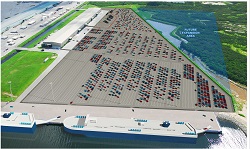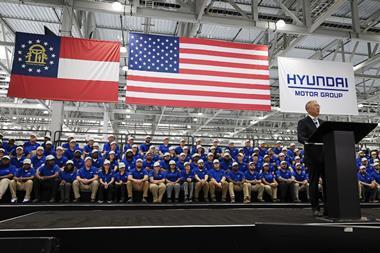 Pasha Automotive Services (PAS), a division of US-based logistics and transport provider, The Pasha Group, is developing a multipurpose ro-ro terminal with Port Manatee, which is sited at the entrance to Tampa Bay in Florida. It is the closest port in the Gulf to Mexico, according to the company, which is expected to see a large rise in vehicle exports.
Pasha Automotive Services (PAS), a division of US-based logistics and transport provider, The Pasha Group, is developing a multipurpose ro-ro terminal with Port Manatee, which is sited at the entrance to Tampa Bay in Florida. It is the closest port in the Gulf to Mexico, according to the company, which is expected to see a large rise in vehicle exports.
Manatee port offers short-sea sailing times that are around a day and a half faster than routes to other vehicle handling ports on the Gulf Coast, according to the port.
“Port Manatee will be able to get autos and other cargos from Mexico to the Florida market faster and more cost-effectively than any other Florida port,” said Carlos Buqueras, Port Manatee’s executive director. “In addition, we anticipate export opportunities into Latin America.”
Speaking at an event held to sign the memorandum of understanding between the two companies, John Pasha, senior vice-president for PAS, said the company wanted to add Port Manatee as “a state-of-the industry quality component in the supply chain for finished vehicles, project cargos and rolling stock”.
“Port Manatee offers a strategic Gulf Coast location for ocean access, facilities and distribution for both import and export automobiles,” he added.
The port has just completed a $13m investment that has expanded the berth to 480 metres long, with a 12-metre draft and has what is described as a “pristine” 16,000 square metre warehouse that the company will develop into a vehicle processing facility. That facility sits on 12-hectares of terminal space, which has the scope to expand to more than 40 hectares.
Port Manatee already handles bulk, breakbulk, container, heavy equipment and project cargo.
“Expansion capability is tremendous,” John Pasha told Automotive Logistics. “The Florida International Gateway – a nearly 3,900-acre [1,600-hectare] greenfield warehouse and distribution development opportunity – is immediately adjacent to Port Manatee, which is served directly by the CSX rail system and Interstates 275, I-75, and nearby I-4. Additional vacant warehouse space is also abundant on port. The beauty of this facility is there is no investment needed to process ro-ro cargo, including short sea auto imports today, and virtually unlimited expansion opportunity with access to the open ocean in less than two hours.”
This is the second announcement for development of a vehicle and ro-ro terminal in the Tampa region in recent months. This past summer, Amports revealed that it would develop a terminal at the port of Tampa with the Tampa Bay Port Authority. The two port terminals will be located about 50km apart.
Services for ocean exports from Mexico are in demand as carmakers look for capacity for shipments to the US and overseas markets. Figures from business analyst IHS Automotive, revealed at this week’s Automotive Logistics Global conference in Detroit, show that Mexican production growth is one of the fastest this decade, rivalling Brazil, Russia and India. By 2015 production will hit 3.3m, split roughly equal between North America’s leading three carmakers and transplant manufacturers.
Completion at Gray’s Harbor
In a separate development on the West Coast, PAS is celebrating the completion of a two-year infrastructure building project at the port of Gray’s Harbor in Washington state. Combined investment between the parties involved in the terminal amounts to $4.5m and work has also been completed on a new $15m rail facility.
Expansion is ongoing at Gray’s Harbor, according to Pasha, and its customers now benefit from more than 24 paved hectares of land surrounded by new security systems, a state of the art Belanger custom carwash system, drive over undercoating application pits, homologation and accessory bays, and a new body and mechanics centre. Full terminal capacity can be expanded to approximately 60 hectares.
The port’s volumes have doubled year over year in the last three years to about 100,000 per year. Siem Car Carriers, Eukor, Pasha Distribution Services and United Road are among those supporting the local import and export operations
“Export unit trains, which are terminating at Gray’s several times per week, are providing an excellent opportunity for import land bridge customers with traffic from Mexico and Asia to reload the regular supply of empty railcars at the port,” said Pasha, adding that this was carried out on the recently built 84-car rail spur which provides access to both the Union Pacific and the BNSF Class 1 railways.
According to the company, new business through the terminal includes a carmaker importing vehicles on a short-sea service from Mexico. Rental car reconditioning for rental cars destined for auction is also booming said the company, with several thousand units passing through the port annually.
John Pasha also said that employment at the port has grown. “We have added two I-CAR certified paint technicians and 12 experienced accessory installers to its local labour force roster,” he said. “Over 140 employees provide a variety of skills from rail unloading to full body shop and accessory programmes.”
A partnership with Gray's Harbor College, which offers an automotive technical training centre, has led to training on the terminal for local apprentices.
Gray's Harbor has also been a major vehicle export hub for Chrysler, in particularly for shipments bound for China.
More on Mexico and short-sea shipping in North America will be discussed this week at the Automotive Logistics Global conference, which can also be followed live for the first time from anywhere in the world from our special Automotive Logistics Global Live website. Log on to watch several sessions streamed in live, post comments and ask questions.

























![Global[1]](https://d3n5uof8vony13.cloudfront.net/Pictures/web/a/d/s/global1_726550.svgz)










